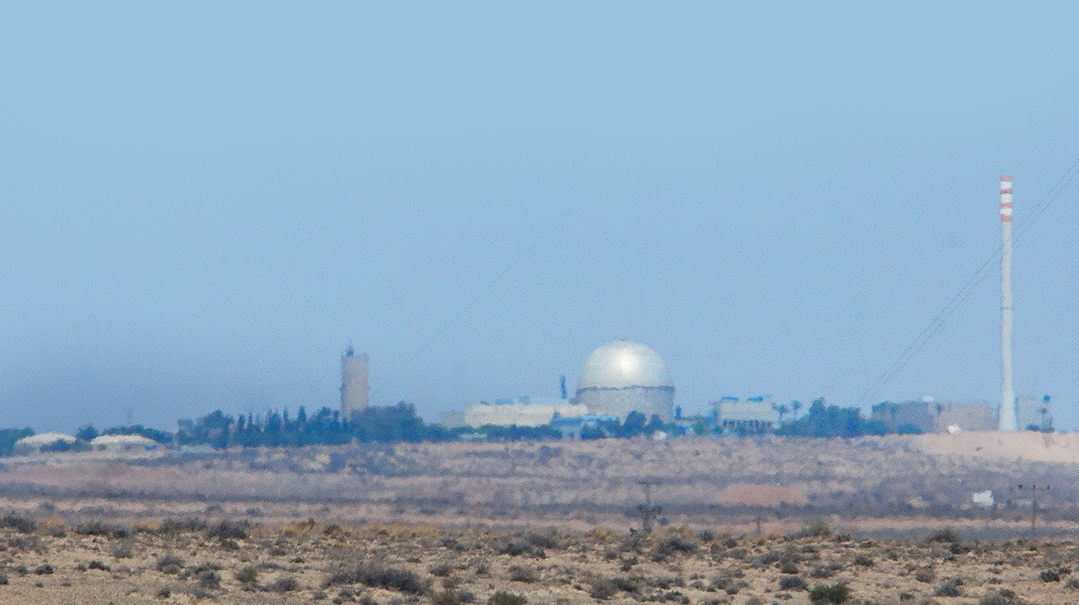What’s Going Down in Dimona?

Is the reactor active, and is the emergence of the photos of a top-secret defense installation a slip-up?

The Backstory: What’s Going Down in Dimona?
Something is afoot in Israel’s nuclear weapons program, and the world is meant to know about it.
An AP news report based on commercially available satellite images that made headlines last week showed the nuclear facility in Dimona undergoing its largest construction work in decades. The photos show a dig about as wide as a football field and several stories deep close to the main reactor. In one image, steam is seen coming from a building near the famous silver dome. AP noted that the Israeli government refused to address its questions on the matter.
So what’s really going on at Dimona? Is the reactor active, and is the emergence of the photos of a top-secret defense installation a slip-up?
Shas MK Yaakov Margi, who worked at Dimona in the past, is convinced that what’s going in is a deliberate misinformation campaign designed to convince the world that the reactor is active.
“The committee on nuclear energy is aware that there are satellites in space and that the pixel resolution limit of 50 centimeters was removed last year,” he says. “They’ve made their own plans.”
The construction of the reactor began in 1950 with French help. For years Israel concealed its purpose even from the United States and pretended it was a textile factory. Since its founding, the reactor, which has now become a massive operation with over 2,000 workers, has produced large amounts of plutonium, the material used for nuclear bombs.
At the Institute for Nuclear Research in Dimona, work used to go on 24 hours a day in three shifts. Some 20 years ago, the work was reduced to two shifts in some stations. Reactivating the reactor would demand approvals from the highest security echelons, as well as extensive security checks.
According to Margi, the chances that the reactor is active are small. The heavy-water reactor has been operational since 1959, and if reports of Israel’s nuclear capabilities are accurate, the country already possesses sufficient nuclear deterrence to guarantee its survival even if Iran does get its hand on a bomb.
The timing of the AP report is significant. It comes as Israel and the US are set to open strategic talks on the Iran nuclear file in light of President Biden’s intention to reenter the deal.
So in a diplomatic world rife with signal-sending, the sound of the diggers in Dimona are meant to be heard in Tehran and Washington — a reminder that Israel isn’t prepared to be sidelined again.
—Eliezer Shulman
111000
The decrease in the number of job seekers registered last week, which, according to the Washington Post, is the largest such fall since August. And while 730,000 Americans applied for unemployment benefits last week, the trend is encouraging.
At the height of the virus, in April 2020, the number of unemployed rose by 7 million in one week. Since then, the total has steadily declined. Another encouraging indication is private spending, which in January reached a seven-month high. The expectation of a speedy return to normalcy is driving up the stocks of airline companies as well as the rest of the tourism, entertainment, and food industries.
And while it’s still unclear if this is just a mirage and the road to a health and economic recovery is long, the economic numbers may mean that the worst of this year is behind us.
—Omri Nahmias.
“Hello, CPAC. Do You Miss Me Yet?”
Banned from social media, former president Trump’s first big political outing after leaving the White House was to CPAC, an annual conservative meet-up that took place in Florida last week. His speech at the event was closely watched as a sign of which way the winds are blowing both within the Republican Party, and Trump himself. Here’s what we learned.
The Party of Trump
“Relax, a Trump Comeback in 2024 Is Not Going to Happen” ran a Politico headline in December after Trump’s loss. His plummeting standing in the Republican Party after the Capitol riots added to the narrative that Trump was finished.
Not so fast. Trump’s rapturous reception in CPAC, as well as a straw poll in which 68% supported him for a 2024 bid, showed his enduring hold on the party.
Unity — on his terms
Trump used his speech to lay to rest the idea that he was going to create his own political party, calling the notion — typically — “fake news.” But the Republican Party is a house divided against itself, to borrow a Lincolnite phrase. Post-Capitol riots, the Never-Trumper wing has grown, with foes such as Sen. Bill Cassidy (R-LA) telling CNN that idolizing Trump is a path to losing elections down the line. So is the GOP doomed to years of internecine fighting? A look at the Democrats — where an uneasy truce between moderates and progressives got Biden elected — is a sign that even in marriages of convenience, both sides can do well.
Still riveting
Trump’s speech — even though much of it was standard Trumpism — was a reminder of how he dominated news cycles for five years through a rapport with a crowd that other politicians struggle to generate. Four years is a long time, but come the post Covid-era, it’s not hard to see him trying the same again at the large rallies he thrives on.
—Gedalia Guttentag
The Othering of Chareidim
It’s still unclear what exactly happened on the Frontier Airlines flight from Miami to La Guardia this week in which a party of chassidim were deplaned, apparently after a young child was spotted not wearing a mask.
The airline’s version — that it was a result of adults refusing to wear masks — was disputed by other passengers, including many non-Jews on the flight. Some went on record afterwards, saying that flight crew had clapped when the group was taken off, and one person testified that he’d heard them refer to “Jews.”
Yossi Gestetner, whose OJPAC Twitter account was the source of many of the videos that emerged, said that regardless of how the story began, the issue was the staff’s reaction. “Besides the fact that the airline’s account doesn’t make sense because the videos show them wearing masks, the issue at hand is the alleged bigotry of the staff.”
In the absence of further video footage, it will be hard to prove things one way or another, but the story is illustration of something that is being felt by visibly frum Jews everywhere.
In the atmosphere of crisis fostered by Covid, communities from Lakewood to London have come under unusual media scrutiny. Charges of willful negligence in the pandemic have thrust otherwise-retiring communities into the spotlight, and a certain Israeli-style “othering” of chareidim has appeared in media on both sides of the Atlantic.
In that atmosphere, it’s not impossible that flight-crew saw the black-clad travelers as a group apart, subject to treatment that they wouldn’t inflict on others.
(Originally featured in Mishpacha, Issue 851)
Oops! We could not locate your form.













